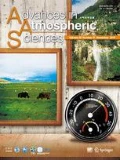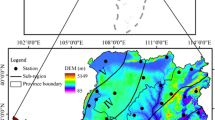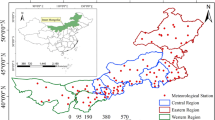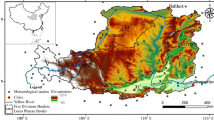Abstract
This study deals with temporal trends in the Penman-Monteith reference evapotranspiration estimated from standard meteorological observations, observed pan evaporation, and four related meteorological variables during 1970–2000 in the Yangtze River catchment. Relative contributions of the four meteorological variables to changes in the reference evapotranspiration are quantified. The results show that both the reference evapotranspiration and the pan evaporation have significant decreasing trends in the upper, the middle as well as in the whole Changjiang (Yangtze) River catchment at the 5% significance level, while the air temperature shows a significant increasing trend. The decreasing trend detected in the reference evapotranspiration can be attributed to the significant decreasing trends in the net radiation and the wind speed.
Similar content being viewed by others
References
Allen, R. G., L. S. Pereira, D. Raes, and M. Smith, 1998: Crop evapotranspiration—Guidelines for computing crop water requirements. AO Irrigation & Drainage Paper 56, Food and Agriculture Organization, 1998, ISBN 92-5-104219-5.
Blaney, H. F., and W. D. Criddle, 1950: Determining water requirements in irrigated area from climatological irrigation data. U. S. Department of Agriculture, Soil Conservation Service Tech. Paper. No. 96, 48pp.
Chattopadhyay, N., and M. Hulme, 1997: Evaporation and potential evapotranspiration in India under conditions of recent and future climatic change. Agricultural and Forest Meteorology, 87(1), 55–74.
Chen, D., G. Gao, C.-Y. Xu, J. Guo, and G. Ren, 2005: Comparison of Thorthwaite method and Pan data, with the standard Penman-Monteith estimates of potential evapotranspiration for China. Climate Res., 28, 123–132.
Dyck, S., 1983: Overview on the present status of the concepts of water balance models. New Approaches in Water Balance Compulations (Proceedings of the Hamburg Workshop), A. Van der Beken, and A. Herrmann, Eds, IAHS Publ. No. 148, 3–19.
Hobbins, M. T., J. A. Ramirez, and T. C. Brown, 2001a: The complementary relationship in estimation of regional evapotranspiration: An enhanced advection-aridity model. Water Resour. Res., 37(5), 1389–1403.
Hobbins, M. T., J. A. Ramirez, T. C. Brown, and L. H. J. M. Claessens, 2001b: The complementary relationship in estimation of regional evapotranspiration: The complementary relationship areal evapotranspiration and advection-aridity models. Water Resour. Res., 37(5), 1367–1388.
Hobbins, M. T., J. A. Ramirez, and T. C. Brown, 2004: Trends in pan evaporation and actual evapotranspiration across the conterminous U. S.: Paradoxical or complementary? Geophys. Res. Lett., 31, L13503, doi:10.1029/2004GL019846.
Kaiser, D. P., 2000: Decreasing cloudiness over China: An updated analysis examining additional variables. Geophys. Res. Lett., 27(15), 2193–2196.
Kaiser, D. P., 2001: Assessing observed temperature and cloud amount trends for China over the last half of the twentieth century: What can the sunshine duration tell us? Report No. POO-109147, 12th Symposium on Global Change Studies, sponsored by U. S. Department of Energy.
Liu, B., M. Xu, M. Henderson, and W. Gong, 2004: A spatial analysis of pan evaporation trends in China, 1955–2000. J. Geophys. Res., 109, doi:10.1029/2004JD004511.
Ramirez, J. A., and B. Finnerty, 1996: CO2 and temperature effect on evapotranspiration and irrigated agriculture. Journal of Irrigation and Drainage Engineering, ASCE, 122, 155–163.
Thomas, A., 2000: Spatial and temporal characteristics of potential evapotranspiration trends over China. International Journal of Climatology, 20, 381–396.
Wang, J., Z. Hao, T. Jiang, J. Shi, and T. Zeng, 2003: Study on reference evapotranspiration in the Yangtze River under increasing temperature. Journal of Lake Sciences, 15, 277–288. (in Chinese)
Xu, C.-Y., and V. P. Singh, 2005: Evaluation of three complementary relationship evapotranspiration models by water balance approach to estimate actual regional evapotranspiration in different climate regions. J. Hydrol., 308, 105–121.
Xu, Z. X., and J. Y. Li, 2003: A distributed approach for estimating catchment evapotranspiration: Comparison of the combination equation and the complementary relationship approaches. Hydrol. Process., 17, 1509–1523.
Zhang, Y. L., B. Q. Qin, and W. M. Chen, 2004: Analysis of 40 year records of solar radiation data in Shanghai, Nanjing and Hangzhou in Eastern China. Theor. Appl. Climatol., 78, 217–227.
Author information
Authors and Affiliations
Rights and permissions
About this article
Cite this article
Xu, Cy., Gong, L., Jiang, T. et al. Decreasing reference evapotranspiration in a warming climate—A case of Changjiang (Yangtze) River catchment during 1970–2000. Adv. Atmos. Sci. 23, 513–520 (2006). https://doi.org/10.1007/s00376-006-0513-4
Received:
Revised:
Issue Date:
DOI: https://doi.org/10.1007/s00376-006-0513-4




